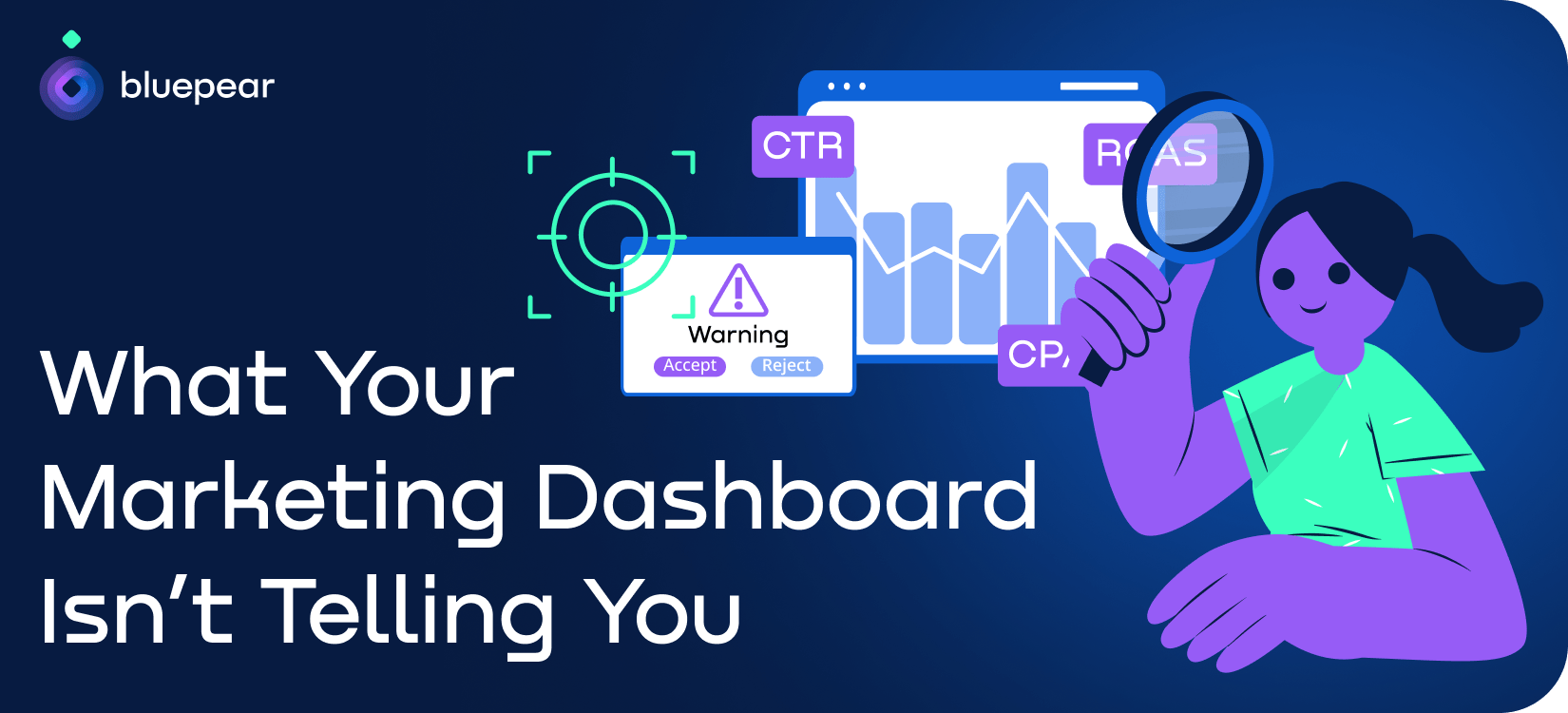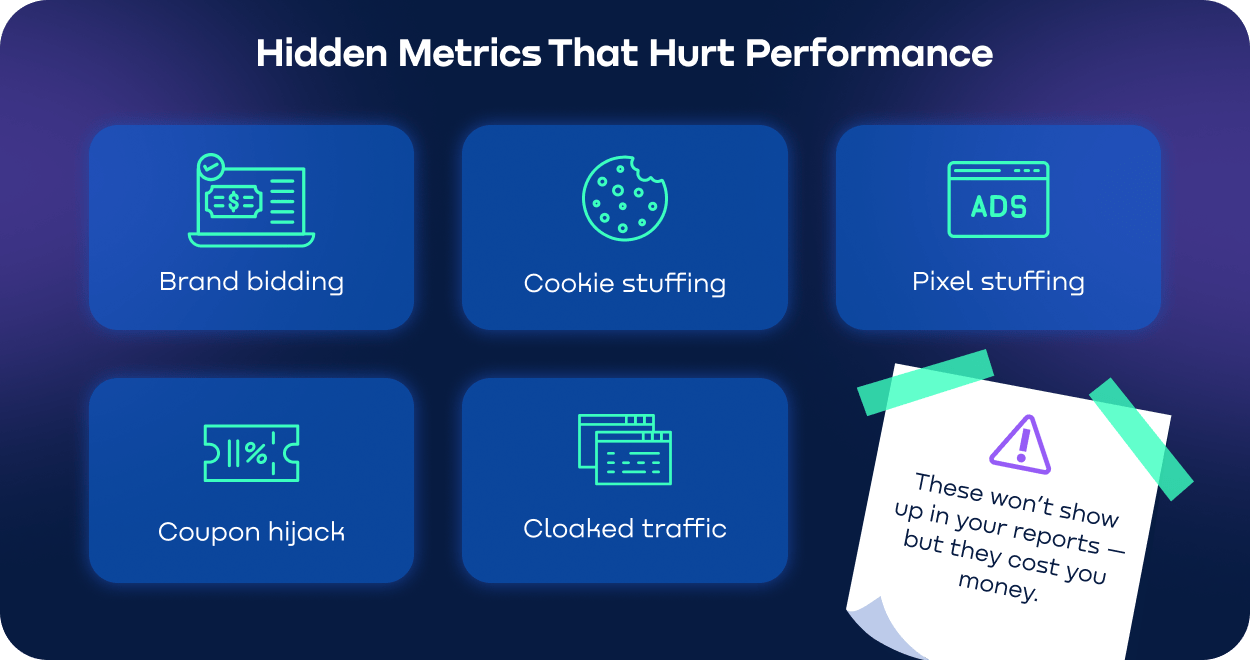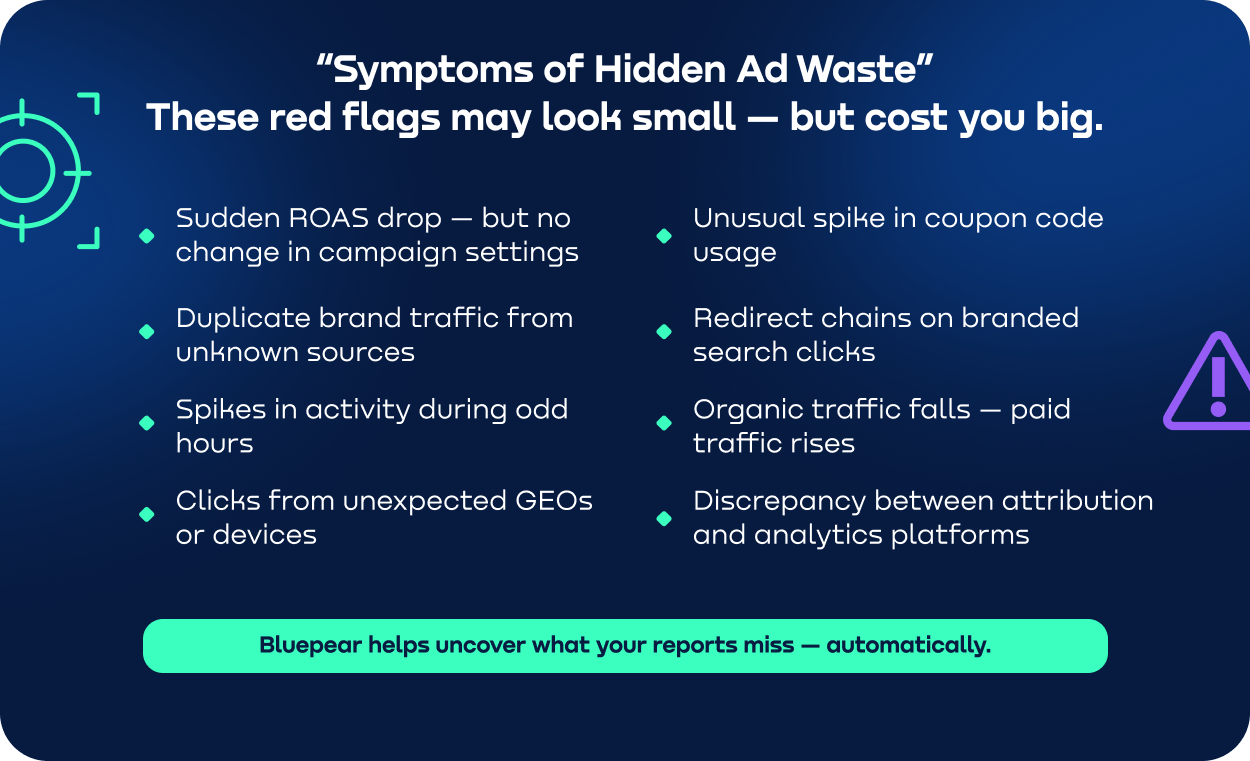
Contents
Intro
Click-through rates (CTR), return on ad spend (ROAS), and cost per acquisition (CPA) have long been the gold standard marketing metrics in performance marketing. However, in 2025, relying solely on these numbers is like driving with one eye closed.
The latest trends in marketing metrics show a growing complexity of digital ecosystems. Attribution models have become fragmented, fraudsters are using more sophisticated techniques, and traditional performance reports often hide more than they reveal. Even experienced marketers miss subtle warning signs until it’s too late — when brand traffic is hijacked, budgets are cannibalized, or partner fraud quietly drains profits. The reality is harsh: many of the biggest risks do not show up in Google Analytics or standard dashboards. These invisible threats affect your ROI and campaign success without triggering any obvious alarms. To truly succeed in optimising marketing in 2025, marketers must look beyond the usual KPIs and incorporate hidden or "shadow" metrics that reveal the real story behind the numbers.
Traditional Metrics Aren’t Enough Anymore
For years, marketing metrics include CTR, ROAS, CPA, and conversion rate as the backbone of campaign evaluation. These are essential for understanding basic performance, but:
• CTR measures clicks relative to impressions, but doesn’t guarantee quality or legitimacy.
• ROAS shows revenue generated per ad dollar spent, yet can mask fraudulent activity or brand cannibalization.
• CPA reflects cost per action but ignores how attribution might be skewed by fraudulent behavior.
Why are these no longer enough? Because these marketing metrics include scratch the surface. They don’t account for hidden losses like brand bidding, pixel stuffing, or coupon fraud that quietly drain budget and skew results.
Latest trends in marketing metrics show a shift towards deeper, more nuanced indicators that reveal what standard metrics miss.
Example: The Disappearing Revenue
A campaign might show:
• ROAS at a healthy 320%
• CPA 22% below industry benchmarks
• CTR increasing steadily by 18% month-over-month
Everything looks perfect on paper. Yet the net revenue remains flat or declines. Why?
Beneath this façade lie hidden drains such as:
• Affiliates aggressively outbidding your branded keywords, cannibalizing your direct traffic
• Fake coupon sites injecting phantom attributions
• Pixel stuffing and cloaked traffic inflating impressions and clicks without real conversions
These nuances rarely show up in standard dashboards or reports — a blind spot for most marketing teams.
Introducing: Hidden Performance Signals (aka Shadow Metrics)
The latest trends in marketing metrics emphasize tracking Shadow Metrics — subtle, indirect signals critical for uncovering real performance issues:
• Brand Overlap Rate: Percentage of branded clicks coming from affiliates or suspicious sources
• Coupon Attribution Skew: Portion of conversions attributed to coupon codes never actually used by genuine customers
• Redirect Chain Density: Number of URL redirects before the final landing page, which may indicate cloaking or fraud
• Post-Click Engagement Drop: Sudden fall in time-on-site or spikes in bounce rate on paid clicks, signaling poor-quality traffic
These hidden metrics are often missing from standard reports but are vital for optimising marketing efforts and protecting budgets. This focus on latest trends in marketing metrics reflects a growing awareness that traditional metrics alone can’t fully capture true campaign health.
The Real Performance Killers Marketers Overlook
Behind the polished numbers on your campaign dashboards lurk several stealthy threats that quietly sabotage your results and drain your budget. These hidden killers distort your metrics, making your performance look better than it really is — until the damage is done. For years, marketing metrics include familiar indicators like CTR, ROAS, and CPA, but the latest trends in marketing metrics reveal that these only tell part of the story. Here’s what’s really eating into your ROI:
Brand Bidding
Imagine paying twice for the same customer: once through your own ads, and again when competitors or affiliates bid on your branded keywords. This sneaky tactic steals your highest-intent traffic, cannibalizing organic visits and inflating your paid costs without showing a clear warning.
Cookie Stuffing
Fake clicks or milliseconds-long impressions drop cookies onto users who never genuinely engaged with your ads. This means you’re unfairly giving away attribution credit for conversions that would’ve happened naturally — a hidden drain on your CPA and overall budget.
Pixel Stuffing
Think invisible pixels in tiny, hidden iframes magically racking up impressions. These fake views blow up your CTR numbers, tricking your reports into showing engagement where none exists — all while bleeding ad spend on phantom traffic.
Cloaked Traffic
Bots and proxy users wear disguises, slipping past your quality filters with false personas. They click and bounce without converting, inflating your click metrics but leaving your sales numbers untouched.
Domain Spoofing
Fraudsters impersonate premium publishers, selling you fake ad inventory disguised as top-tier traffic. Your campaigns look like they’re reaching valuable audiences, but in reality, you’re pouring money into junk views that don’t convert.
Coupon Hijacking
Unscrupulous affiliates or automated tools sneak in fake coupon codes late in the purchase journey, hijacking last-click attribution. This steals credit for sales your marketing didn’t influence, misguiding your optimisation and budget allocation.
Recognizing and combating these hidden killers is essential to get honest, actionable marketing metrics — the kind that the latest trends in marketing metrics focus on uncovering. Embracing these insights means moving beyond the surface numbers to truly protect your marketing ROI. These latest trends are reshaping how marketers identify threats and safeguard budgets in an increasingly complex landscape.

Types of Hidden Threats
In the complex world of performance marketing, several hidden threats silently distort your marketing, leading to misguided decisions and wasted budget. For years, marketing metrics include CTR, ROAS, and CPA as fundamental indicators, but the latest trends in marketing metrics show these alone aren’t enough to expose all issues. Here’s a breakdown of the most common types and how each one skews your data:
Brand Bidding Competitors or affiliates bid on your branded keywords, diverting high-intent traffic away from your own campaigns. This inflates your paid clicks while cannibalizing organic traffic, making CTR and ROAS appear artificially healthy but masking lost revenue.
Cookie Stuffing Fraudsters drop tracking cookies without genuine user engagement, claiming credit for conversions you would have gained anyway. This skews CPA and attribution metrics, making your campaigns seem more cost-effective than they truly are.
Pixel Stuffing Invisible pixels or iframes load ad impressions without user interaction, inflating your impression and CTR numbers. The result is misleading engagement data and budget spent on fake or low-quality traffic.
Cloaked Traffic Bots or proxy users disguise themselves as legitimate visitors to bypass fraud filters. These fake clicks show up in your reports as real traffic, but they rarely convert, leading to inflated CTRs and depressed conversion rates.
Domain Spoofing Fraudsters impersonate reputable websites to sell low-quality or fake traffic through programmatic channels. Your ad spend appears to go to premium sources, but in reality, it funds worthless impressions, distorting your ROAS and conversion data.
Coupon Hijacking Unauthorized parties inject fake or stolen coupon codes at checkout, capturing attribution credit for sales they didn’t influence. This inflates conversion numbers tied to promotions and misguides optimisation efforts based on misleading coupon performance.
Each of these hidden threats disrupts your standard marketing metrics, making it critical to dig deeper into shadow metrics — a focus at the heart of the latest trends in marketing metrics. By expanding beyond traditional KPIs, marketers can uncover the real story behind campaign performance and protect their budgets from these invisible drains.

How to Track Hidden Metrics and Why It Matters
Why Manual Audits Don’t Cut It
You can’t fix what you can’t see — but the volume and velocity of traffic, clicks, and redirects make manual audits impractical. Threats evolve hourly, and even seasoned analysts often miss critical signals.
Optimising marketing in 2025 demands:
• Behavioral analysis at scale
• Real-time tag and redirect mapping
• Cross-channel attribution validation
Data Sources You Actually Need
To surface these hidden threats, you need to combine:
• Raw traffic logs
• Affiliate referral maps
• Coupon attribution databases
• Session-level engagement metrics
• Paid vs. organic clickstream comparisons
Why Bluepear Makes the Invisible Visible
Standard dashboards were never designed for fraud detection or to spot subtle cannibalization.
Bluepear continuously monitors:
• Brand traffic abuse
• Suspicious referral loops
• Anomalous user behaviors
• Skewed attribution flows
It integrates affiliate, paid, and organic channels into a unified view that reflects the true marketing metrics including essential for making informed decisions.
Case Example: Performance Drop Without Clear Reason
Scenario: Your ROAS suddenly drops 28% over two weeks. CTR is stable, CPA even improves. No obvious campaign issues.
Bluepear Audit Findings
• Cloaked redirects stealing brand traffic
• 17% of clicks routed through affiliate jump pages
• 34% of conversions claimed by injected coupon fraud
Result: After intervention based on Bluepear insights, brand traffic was restored, real ROAS increased by 41%, and affiliate payouts dropped 22%.
Bluepear as a Source of “True” Performance Metrics
Bluepear is more than a fraud detection tool — it offers a fresh perspective on marketing metrics that matter.
What It Delivers:
• Accurate source-to-sale mapping
• Real-time anomaly detection across traffic, attribution, conversions
• Instant alerts on risky behaviors
• Visual dashboards highlighting hidden threats
How to Integrate:
• Plug seamlessly into GA, Looker, Tableau, and other analytics stacks
• Enrich existing campaign reports with behavioral signals
• Use real-time flags to pause or adjust campaigns immediately
• Reacting to Fraud in Real Time
Bluepear empowers teams to:
• Blacklist fraudulent sources immediately
• Dynamically adjust attribution models
• Monitor suspicious spikes as they happen
Conclusion
In 2025, marketing metrics include no longer just numbers on a dashboard. Real performance depends on uncovering the invisible risks silently eating your ROI. To win at optimising marketing, you must track and react to Shadow Metrics — the hidden signals your standard reports miss.
Don’t let your campaigns bleed money quietly.

